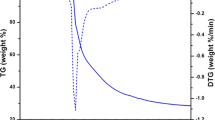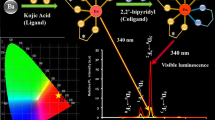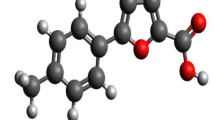Abstract
Five novel europium(III) complexes with 2-[4-(dibutylamino)-2-hydroxybenzoyl]benzoic acid (DAHB) as primary ligand and bathophenanthroline (batho), 2,2’-bipyridyl (bipy), 5,6-dimethyl-1,10-phenanthroline (dmph), 1,10-phenanthroline (phen) as ancillary ligands were synthesized via solution precipitation method. The structural formulae of synthesized complexes were speculated to be Eu(DABH)3·2H2O (C1), Eu(DABH)3·batho (C2), Eu(DABH)3·bipy (C3), Eu(DABH)3·dmph (C4) and Eu(DABH)3·phen (C5) by elemental analysis, infrared spectroscopy and proton nuclear magnetic resonance spectroscopy (1H-NMR). The photoluminescent properties and thermal stability of the complexes were investigated by photoluminescent spectroscopy and thermogravimetric analysis (TG-DTG), respectively. The Commission Internationale de I’ Eclairage (CIE) color coordinates, Judd–Ofelt intensity parameter (Ω2), total quantum yield, intrinsic quantum efficiency and energy transfer dynamics of complexes were also explored. The excitation spectra of complexes are extended up to visible region. These complexes exhibit characteristic photoemission of Eu3+ metal ion with high color purity in red region attributed to efficient energy transfer from ligand to metal ion. The replacement of water molecules from coordination sphere of europium ion by ancillary ligands results in enhancement of luminescent properties of the C2–C5 complexes, indicating that ancillary ligands act as additional light harvesting centers in sensitization phenomenon. The thermal studies show that these complexes are suitable for meeting the requirement of temperature for fabrication of OLEDs devices.











Similar content being viewed by others
References
Gallardo H, Conte G, Bortoluzzi AJ, Bechtold IH, Pereira A, Quirino WG, Legnani C, Cremona M. Synthesis, structural characterization, and photo and electroluminescence of a novel terbium(III) complex: {tris(acetylacetonatonate)[1,2,5]thiadiazolo[3,4-f][1,10]phenanthroline}terbium(III). Inorg Chim Acta. 2011;365(1):152.
Wang L, Li B, Zhang L, Li P, Jiang H. An optical anion chemosensor based on a europium complex and its molecular logic. Dyes Pigm. 2013;97(1):26.
Song X, Wang L, Zheng Q, Liu W. Synthesis, crystal structure and luminescence properties of lanthanide complexes with a new bridging furfurylsalicylamide ligand. Inorg Chim Acta. 2012;391:171.
Souza AP, Paz FAA, Freire RO, Calos LD, Malta OL, Alves S Jr, de Sa GF. Synthesis, crystal structure, and modelling of a new tetramer complex of europium. J Phys Chem B. 2007;111(31):9228.
Tsaryuk V, Zolin V, Zhuravlev K, Kudryashova V, Legendziewicz J, Szostak R. Blocking effect of ligand spacer groups on the luminescence excitation of europium aromatic carboxylates. J Alloys Compd. 2008;451(1):153.
Kuriki K, Koike Y, Okamoto Y. Plastic optical fiber lasers and amlifiers containing lanthanide complexes. Chem Rev. 2002;102(6):2347.
Rasanen M, Takalo H, Rosenberg J, Makela J, Haapakka K, Kankare J. Study on photophysical properties of Eu(III) complexes with aromatic β-diketones-role of charge transfer states in the energy migration. J Lumin. 2014;146(25):211.
Jiu HF, Liu GD, Zhang ZJ, Fu YH, Chen JC, Fan T, Zhang LX. Fluorescence enhancement of Tb(III) complex with a new β-diketone ligand by 1,10-phenanthroline. J Rare Earths. 2011;29(8):741.
Mwaura JK, Mathai MK, Chen C, Papadimitrakopoulos F. Light emitting diodes prepared from terbium-immobilized polyurea chelates. J Macromol Sci A. 2003;40(12):1253.
Whan RE, Crosby GA. Luminescence studies of rare earth complexes: benzoylacetonate and dibenzoylmethide chelates. J Mol Spectrosc. 1962;8(1–6):315.
Rao CN, Ferraro JR, editors. Spectroscopy in Inorganic Chemistry. New York: Academic Press; 1971. 2.
Lasker IR, Chen TM. Tuning of wavelengths: synthesis and photophysical studies of iridium complexes and their applications in organic light emitting devices. Chem Mater. 2004;16(1):111.
Bao Z, Lovinger AJ, Brown J. New air-stable n-channel organic thin film transistors. J Am Chem Soc. 1998;120(1):207.
Parra DF, Mucciolo A, Brito HF. Green luminescence system containing a Tb3+-β-diketonate complex doped in the epoxy resin as sensitizer. J Appl Polym Sci. 2004;94(3):865.
Bala M, Kumar S, Taxak VB, Boora P, Khatkar SP. Terbium(III) complexes sensitized with β-diketone and ancillary ligand: synthesis, elucidation of photoluminescence properties and mechanism. J Mater Sci-Mater Electron. 2016;27(9):9306.
Feng J, Zhang H. Hybrid materials based on lanthanide organic complexes: a review. Chem Soc Rev. 2013;42(1):387.
Yang Y, Zhang SY. Study of lanthanide complexes with salicylic acid by photoacoustic and fluorescence spectroscopy, Spectrochim. Acta A. 2004;60(8–9):2065.
Nakayama T, Tsutsui T. Enhancement in 1-D optical resonator devices with organic films. Synth Met. 1997;91(1–3):57.
Kamino S, Horio Y, Komeda S, Minoura K, Ichikawa H, Horigome J, Tatsumi A, Kaji S, Yamaguchi T, Usami Y, Hirota S, Enomoto S, Fujita Y. A new class of rhodamine luminophores: design, synthesis and aggregation-induced emission enhancement. Chem Commun. 2010;46(47):9013.
Liu JY, Ren N, Zhang JJ, Zhang CY. Preparation, thermodynamics property and antimicrobial activity of some rare earth (III) complexes with 3-bromo-5-iodobenzoic acid and 1,10-phenanthroline. Thermochim Acta. 2013;570:51.
Tian L, Ren N, Zhang JJ, Sun SJ, Ye HM, Bai JH, Wang RF. Synthesis, crystal structure, and thermal decomposition kinetic of the complex of dysprosium benzoate with 2,2’-bipyridine. J Chem Eng Data. 2009;54(1):69.
Devi R, Chahar S, Khatkar SP, Taxak VB, Boora P. Relative study of luminescent properties with Judd-Ofelt characterization in trivalent europium complexes comprising ethyl-(4-fluorobenzoyl) acetate. J Fluoresc. 2017;27(4):1349.
Yang C, Luo J, Ma J, Lu M, Liang L, Tong B. Synthesis and photoluminescent properties of four novel trinuclear europium complexes based on two tris-β-diketones ligands. Dyes Pigm. 2012;92(1):696.
Bhacca NS, Selbin J, Wander JD. Nuclear magnetic resonance spectra of 1:1 adducts of 1,10-phenanthroline and α, α′-bipyridyl with tris[2,2,6,6-tetramethylheptane-3,5-dionato] complexes of the lanthanides. J Am Chem Soc. 1972;94(25):8719.
Utochnikova VV, Solodukhin NN, Aslandukov AN, Marciniak L, Bushmarinov IS, Vashchenko AA, Kuzmina NP. Lanthanide tetrafluorobenzoates as emitters for OLEDs: New approach for host selection. Org Elec. 2017;44:85.
Shao G, Li Y, Feng K, Gan F, Gong M. Diphenylethyne based β-diketonate europium(III) complexes as red phosphor applied in LED. Sens Actuators B. 2012;173(1):692.
Wang H, He P, Yan H, Gong M. Synthesis, characteristics and luminescent properties of a new europium(III) organic complex applied in near UV LED. Sens Actuators, B. 2011;156(1):6.
Gusev AN, Hasegawa M, Shul’gin VF, Nishchymenko G, Linert W. Photophysical studies on ternary mixed ligand europium complexes containing pyridyltriazolylmethane and 1,3-diketonate. Inorg Chim Acta. 2014;414:71.
Liu S, Su W, Pan R, Zhou X. Red emission of Eu(III) complex based on 1-(7-(tert-butyl)-9-ethyl-9H-carbazol-2-yl)-4,4,4-trifluorobutane-1,3-dione excited by blue light. Chin J Chem Phys. 2012;25(6):697.
Francis B, Ambilli Raj DB, Reddy MLP. Highly efficient luminescent hybrid materials covalently linking with europium(III) complexes via a novel fluorinated β-diketonate ligand: synthesis, characterization and photophysical properties. Dalton Trans. 2010;39(34):8084.
Wang YB, Zheng XJ, Zhuang WJ, Jin LP. Hydrothermal synthesis and characterization of novel lanthanide 2,2-diphenyldicarboxylate complexes. Eur J Inorg Chem. 2003;2003(7):1355.
Yu J, Deng R, Sun L, Li Z, Zhang H. Photophysical properties of a series of high luminescent europium complexes with fluorinated ligands. J Lumin. 2011;131(2):328.
Zucchi G, Murugesan V, Tonfelier D, Aldakov D, Jeon T, Yang F, Thuery P, Ephritikhine M, Geffroy B. Solution, solid state, and film properties of a structurally characterized highly luminescent molecular europium plastic material excitable with visible light. Inorg Chem. 2011;50(11):4851.
Divya V, Biju S, Verma RL, Reddy MLP. Highly efficient visible light sensitized red emission from europium tris[1-(4-biphenoyl)-3-(2-fluoroyl)propanedione](1,10-phenanthroline) complex grafted on silica nanoparticles. J Mater Chem. 2010;20(25):5220.
Li HF, Yan PF, Chen P, Wang Y, Xu H, Li GM. Highly luminescent bis-diketone lanthanide complexes with triple-stranded dinuclear structure. Dalton Trans. 2012;41(3):900.
Brito HF, Malta OL, Souza LR, Menezes JFS, Carvalho CAA. Luminescence of the films of europium(III) with thenoyltrifluoroacetonate and macrocyclics. J Non-Cryst Solids. 1999;247(1–3):129.
Zhang X, Zhou F, Shi J, Gong M. Sr3.5Mg0.5Si3O8Cl4:Eu2+ bluish-green-emitting phosphor for NUV-based LED. Mater Lett. 2009;63(11):852.
Teotonio EES, Brito HF, Felinto MCFC, Kodaira CA, Malta OL. Luminescence investigations on Eu(III) thenoyltrifluoroacetonate complexes with amide ligands. J Coord Chem. 2003;56(10):913.
Ferreira RAS, Nobre SS, Granadeiro CM, Nogueira HIS, Carlos LD, Malta OL. A theoretical interpretation of the abnormal 5D0 → 7F4 intensity based on the Eu3+ local coordination in the Na9[EuW10O36]·14H2O polyoxometalate. J Lumin. 2006;121:561.
Carlos LD, Messaddeq Y, Brito HF, Ferreira RAS, Bermudez VD, Rebeiro SJL. Full-color phosphors from europium(III)-based organosilicates. Adv Mater. 2000;12(8):594.
Ferreira R, Pires P, de Castro B, Ferreira RAS, Carlos LD, Pischel U. Zirconium organophosphonates as photoactive and hydrophobic host materials for sensitized luminescence of Eu(III), Tb(III), Sm(III), and Dy(III). New J Chem. 2004;28(12):1506.
Xu H, Yin K, Huang W. Synthesis, photophysical and electroluminescenct properties of a novel bright light-emitting Eu3+ complex based on a fluorene-containing bidentate aryl phosphine oxide. Syn Met. 2010;160(19–20):2197.
Taha ZA, Ajlouni AM, Al-Hassan KA, Hijaki AK, Faiq AB. Syntheses, characterization, biological activity and fluorescence properties of bis-(salicylaldehyde)-1,3-propylenediimine Schiff base ligand and its lanthanide complexes. Spectrochim Acta A Mol Biomol Spectrosc. 2011;81(1):317.
Gawryszewska P, Sokolnicki J, Legendziewicz J. Photophysics and structure of selected lanthanide compounds. Coord Chem Rev. 2005;249(21–22):2489.
Greenham NC, Samuel IDW, Hayes GR, Philips RT, Kessener YARR, Moratti SC, Holmes AB, Friend RH. Measurement of absolute photoluminescence quantum effiencies in conjugated polymers. Chem Phys Lett. 1995;241(1–2):89.
Zhang A, Zhang J, Pan Q, Wang S, Jia H, Xu B. Synthesis, photoluminescence and intramolecular energy transfer model of a dysprosium complex. J Lumin. 2012;132(4):965.
Reddy MLP, Divya V, Pavithran R. Visible-light sensitized luminescent europium(III)-β-diketonate complexes: bioprobes for cellular imaging. Dalton Trans. 2013;42(43):15249.
Latva M, Takalo H, Mukkala VM, Matachescu C, Ubis JCR, Kankare J. Correlation between the lowest triplet state energy level of the ligand and lanthanide(III) luminescence quantum yield. J Lumin. 1997;75(2):149.
Ilmi R, Hasan N, Liu J, Mara D, Deun RV, Iftikhar K. Effect of 2,4,6-tri(2-pyridyl)-1,3,5-triazine on visible and NIR luminescence of lanthanide tris(trifluoroacetylacetonates). J Photochem Photobiol A. 2017;347:116.
Dutra JDL, Gimenez IF, da Costa Junior NB, Freire RO. Theoretical design of highly luminescent europium(III) complexes: a factorial study. J. Photochem. Photobio. A. 2011;217(2–3):389.
Acknowledgements
This work was financially supported by the Junior Research Fellowship (JRF) from University Grants Commission, New Delhi, India (No. 2061410096).
Author information
Authors and Affiliations
Corresponding author
Electronic supplementary material
Below is the link to the electronic supplementary material.
Rights and permissions
About this article
Cite this article
Dhankhar, P., Devi, R., Devi, S. et al. Synthesis and photoluminescent performance of novel europium (III) carboxylates with heterocyclic ancillary ligands. Rare Met. 41, 1342–1352 (2022). https://doi.org/10.1007/s12598-019-01261-y
Received:
Revised:
Accepted:
Published:
Issue Date:
DOI: https://doi.org/10.1007/s12598-019-01261-y




